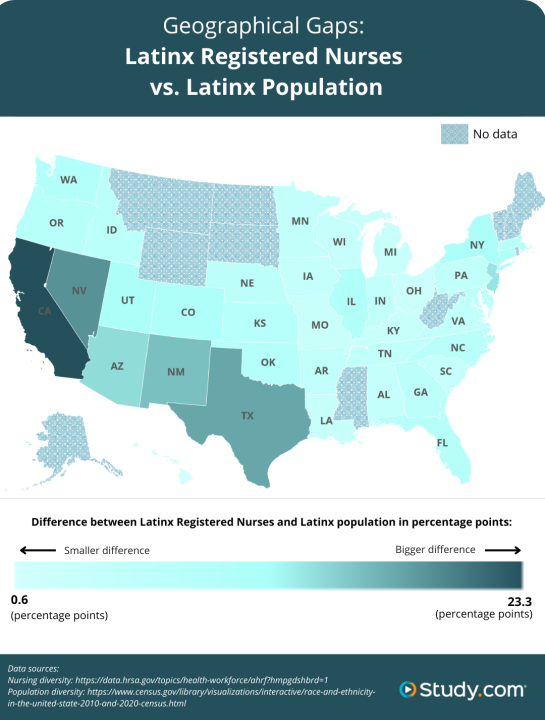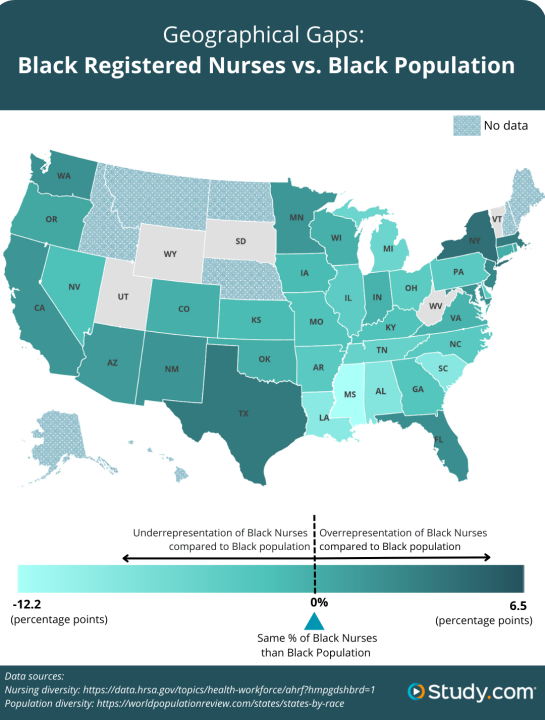Racially diverse nurses can improve patient outcomes, but representation in the US health care system is strikingly uneven

Canva
Racially diverse nurses can improve patient outcomes, but representation in the US health care system is strikingly uneven
A Black and a Latina nurse in scrubs stand side by side smiling
Access to racially diverse health care providers is a crucial factor in health care outcomes that has gained attention in recent years. The absence of representation from the same racial or ethnic group among health care providers can lead to cultural misunderstandings and language barriers. These issues, combined with unconscious biases, can adversely affect health care outcomes.
In the U.S., the percentage of registered nurses who identify as non-Hispanic white varies from state to state from as much as 93.1% to a few as 24.1%. This indicates that depending on the state, patients may encounter differing levels of racial and ethnic representation among nursing staff.
Using Census Bureau and other governmental data, Study.com investigated how well Black and Latinx communities are represented within the nursing profession. The analysis revealed a strikingly uneven landscape of representation across the nation.
How racial diversity affects health care outcomes
Before we delve into the data, let’s look at why racial diversity matters in nursing. These are some of the ways patients benefit from racially diverse nursing staffs:
Cultural competence: Patients from diverse backgrounds often have unique health care needs influenced by their cultural beliefs and practices. For example, religious beliefs can shape preferences around medical treatments, such as fasting during holy periods or declining certain procedures. Some cultures have specific gender norms and expectations about modesty, which might impact a patient’s comfort with a health care provider of the opposite gender or certain procedures.
A health care workforce that shares patients’ varying backgrounds can better understand and address these needs, leading to improved patient experiences and outcomes.
Trust and communication: Patients are more likely to trust and communicate effectively with health care providers who share their racial or ethnic backgrounds. When health care providers are familiar with their patient’s cultural backgrounds, they are better equipped to communicate respectfully and interpret body language accurately. This helps minimize barriers, leading to improved communication and patient understanding.
Patient satisfaction: Research indicates that patients who receive care from providers of the same race or ethnicity report higher satisfaction levels. Patients might experience decreased satisfaction if they face communication challenges or perceive racial bias when treated by physicians of a different race. Shared racial or ethnic backgrounds can positively influence patient experiences, trust, and overall satisfaction with care.
Representation of Hispanic, Latinx, and Black registered nurses
We looked at Health Resources & Services Administration data to explore the number of Hispanic, Latinx, and Black registered nurses, focusing on each state where such information was accessible. We compared the numbers to the total population of Latinx and Black people in those same states, based on figures from the U.S. Census Bureau and World Population Review. The goal was to cast a spotlight on which states had the most noticeable gaps between the size of their Latinx and Black communities and their corresponding registered nurse representation.
We focused on the two largest racial minorities in the U.S. Please note that in this analysis, Latinx is inclusive of people who identify as Hispanic. While the data researchers employed the term “Latino,” this article will use the gender-neutral term “Latinx” to refer to the same group. The percentages of Black or Latinx registered nurses represent the proportion of these groups within the registered nursing workforce, not the overall state population.
![]()

Study.com
Latinx representation among registered nurses across the US
A geographic map of the US showing Latinx registered nurses in each state
California stands out with the highest gap in Latinx representation in nursing. Despite having a Latinx population of 39.4%, only 16.1% of the state’s registered nurses identify as Latinx, a staggering difference of 23.3 percentage points. The states with higher racial discrepancies are more likely to have issues with trust and poor communication between health care providers and patients.
Other states also show significant representation gaps. Nevada, with a Latinx population of 28.7%, has a mere 9.7% of registered nurses identifying as Latinx, resulting in a gap of 19 percentage points. States such as Arizona, Texas, and New Mexico also show double-digit gaps.
At the other end of the spectrum, Hawaii comes closest to representation parity with a minimal 0.6 percentage-point gap. However, even this island state has yet to achieve perfect alignment.
This disparity across states underscores the urgent need to address the underrepresentation of Latinx individuals in nursing, a profession vital for the health of these communities.

Study.com
Black representation among registered nurses across the US
A geographic map of the US showing Black registered nurses in each state against the Black population of each
Switching focus to the Black community, the data unveils that while no state presently bears the disparity that California does for Latinx registered nurses, the percentage point differences between the proportion of Black nurses and the total Black population in each state is much broader, and thus deeper, touching nearly every state, coast to coast.
In Mississippi, a significant difference of 12.2 percentage points emerges, indicating a lower representation of Black registered nurses in relation to the Black population. Trailing closely are Louisiana and South Carolina, with substantial gaps of 9.0 percentage points and 8.8 percentage points, respectively.
Similar trends of underrepresentation are witnessed in Alabama, Michigan, Tennessee, Delaware, Illinois, Ohio, Arkansas, and North Carolina. However, the District of Columbia presents a stark contrast, revealing an overrepresentation of 6.5 percentage points, a higher percentage of Black RNs compared to the state’s overall Black population. Other states like New York and Texas also display a significant overrepresentation, whereas the West and Southwest, from Arizona through Oregon, presents a difference ranging from a modest 0.3 percentage points to a notable -0.7% percentage points.
This story was produced by Study.com and reviewed and distributed by Stacker Media.
